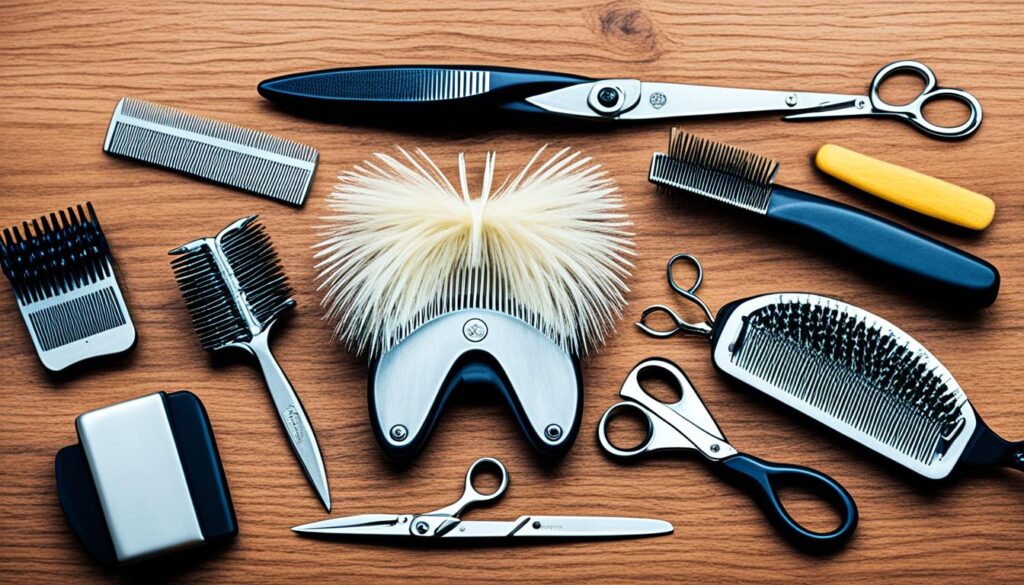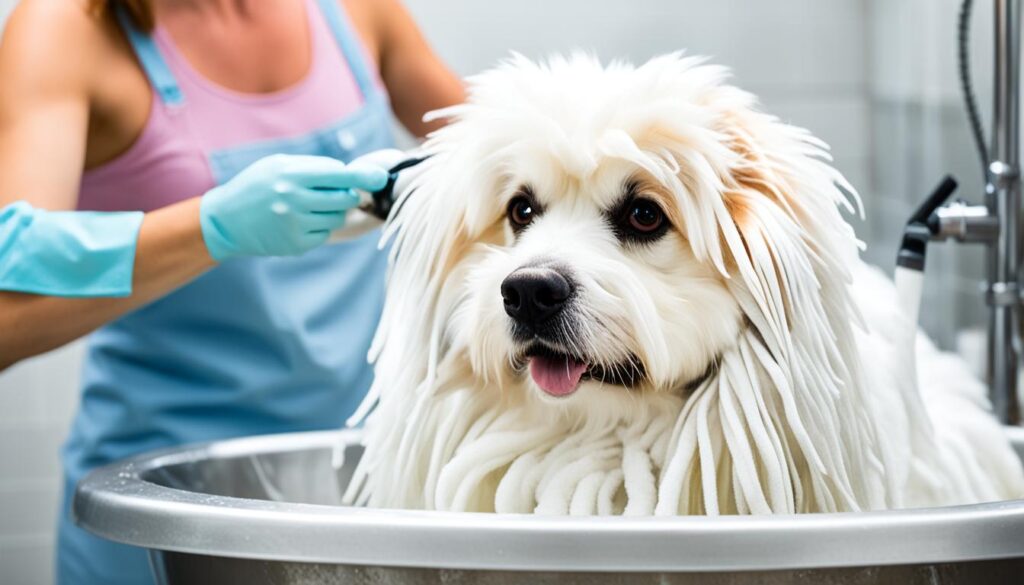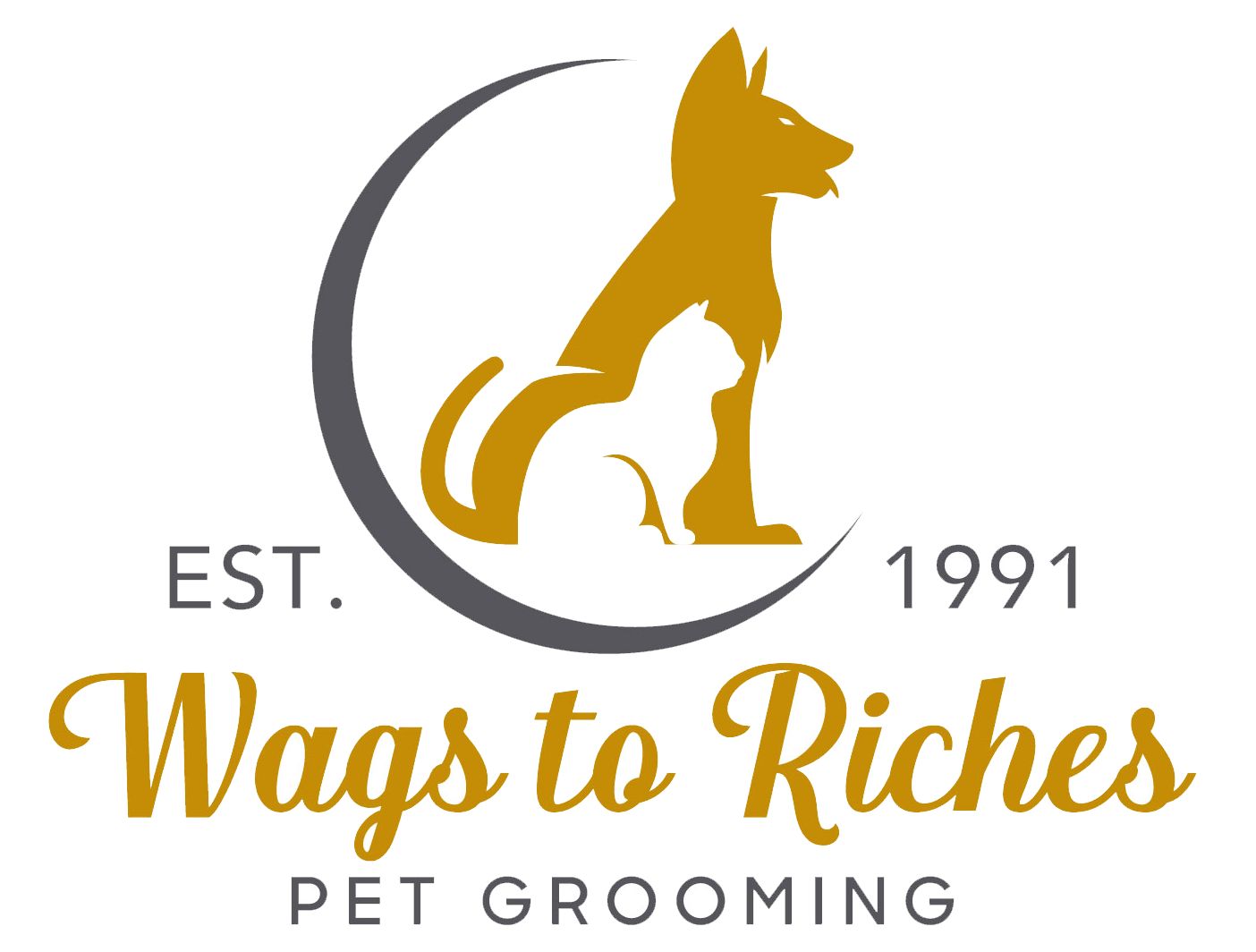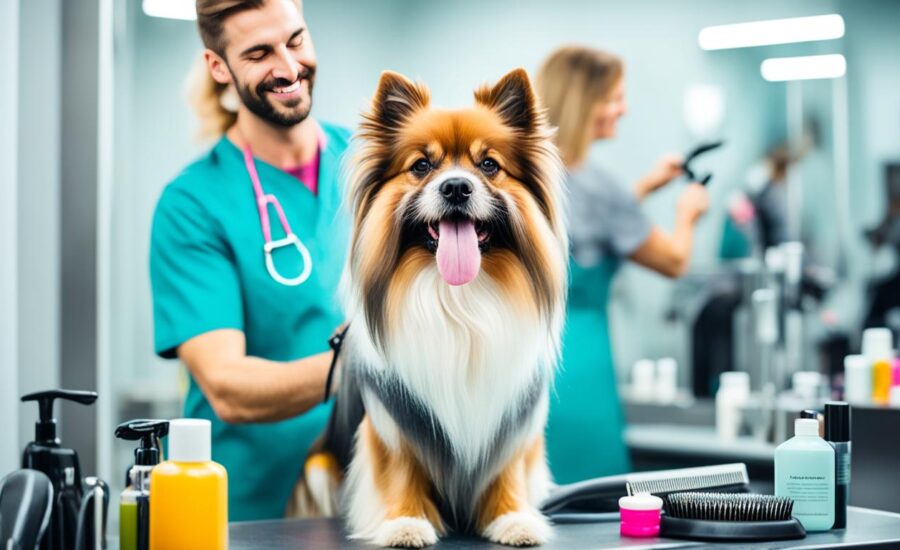The long, beautiful fur of dogs like Collies, Afghans, and Bernese Mountain Dogs requires commitment. Each shiny lock shows the effort of grooming tips for long-haired dog breeds that prevent tangles. But keeping your furry friend looking and feeling their best involves more than just grooming. Let’s discover the secrets to a maintained dog’s coat that brings out both beauty and wellness.
While their beautiful fur wins over hearts, caring for long-haired dogs is serious work. Without the right pet grooming techniques, your dog could end up with more than just messy hair. Mats and tangles could turn snuggling into a battle with the brush. Regular grooming is needed to keep your pet comfy and healthy.
By setting a grooming routine, you do more than just keep their coat looking good. You build a strong bond, showing them grooming is caring. Follow our tips for a coat that’s clean and shiny, showing your pet is both happy and healthy.
Key Takeaways
- Maintain the beauty and health of long-haired dogs with a consistent grooming routine.
- Prevent matting and tangling to ensure your pet’s comfort and well-being.
- Discover the right pet grooming techniques tailored for different long-haired breeds.
- Learn why keeping your long-haired dog groomed is as much about health as it is about good looks.
- Acknowledge the role of grooming in strengthening the bond between you and your furry friend.
Understanding the Needs of Long-Haired Dog Breeds
For owners of long-haired dogs, adopting the best grooming practices is crucial. These magnificent canines need constant care to keep their coats shiny. Let’s explore what it takes to keep these beautiful breeds healthy and looking their best.
Distinguishing Between Dog Hair and Fur
Dog hair and fur might look the same, but they’re different. Dog hair is smoother and finer, which means it gets tangled easily. On the other hand, fur is coarser and sheds more but doesn’t tangle as much. Knowing the difference is key for effective dog grooming tips.
Why Regular Grooming is Crucial for Long-Haired Breeds
Regular grooming is a must for long-haired breeds because their coats attract more dirt and pests. Without grooming, these can cause skin and health problems. Also, grooming regularly makes dogs feel comfortable and healthy, which is a big part of dog care tips.
Common Long-Haired Dog Breeds and Their Grooming Challenges
Breeds like the Shih Tzu, Maltese, and Afghan Hound look stunning but face grooming challenges. Their coats need frequent brushing to avoid tangles, highlighting the need for best grooming practices. Cleanliness is also vital for their appearance and health.
| Breed | Coat Type | Common Grooming Needs |
|---|---|---|
| Shih Tzu | Long, Dense | Daily brushing, professional grooming every 6-8 weeks |
| Maltese | Silky, Straight | Regular detangling, tear stain cleaning |
| Afghan Hound | Long, Fine | Frequent combing, occasional trimming |
Building the Perfect Grooming Toolkit
If you have a long-haired dog, you need the right grooming tools. It’s not just for convenience—it’s crucial. Understanding which tools you need makes grooming easier and keeps your pet looking great.
Choosing the Right Brushes and Combs
For long-haired dogs, brushes and combs are essential. A slicker brush is best for everyday use. It removes loose hair and stops mats. If your dog gets tough knots, use a metal comb or a de-matting brush. These tools also help the skin and hair stay healthy.
Essential Grooming Products for a Healthy Coat
Some products are key for grooming long-haired dogs. Use a special dog shampoo to prevent tangles and keep the coat’s natural oils. A detangling spray makes brushing easier and less stressful. To keep your dog’s coat neat, trim with shears and clippers.
| Tool Type | Purpose | Recommended Use |
|---|---|---|
| Slicker Brush | Daily detangling and smoothing | Use gently to avoid skin irritation |
| Metal Comb | Removing tough knots and tangles | Ideal for grooming sessions post-brush |
| Detangling Spray | Eases the grooming process | Apply before brushing to minimize pulling |
| Shears and Clippers | Trimming and maintaining coat length | Use as needed, especially in warmer months |
Get the right tools and products for grooming. It makes grooming fun for you and your pet. The right tools help keep your dog’s coat beautiful.

Daily Grooming Rituals to Prevent Matting
Adding dog grooming tips to your daily schedule is key, especially for long-haired dogs. Starting a steady grooming routine for long-haired breeds helps avoid mats. It keeps your pet looking good and feeling comfy. Daily brushing is a top Grooming Tip for Long-Haired Dog Breeds. It stops tangles and helps the skin and coat stay healthy.
Brushing daily is vital, especially on the legs and belly where mats often happen. Use a long-toothed comb or a slicker brush. These tools help you gently tackle knots and shed hair. This habit doesn’t just keep the coat tidy. It also boosts blood flow and skin health, leading to better overall health.
| Grooming Tool | Usage Frequency | Benefit |
|---|---|---|
| Long-toothed comb | Daily | Detangles and removes loose hair |
| Slicker brush | 2-3 times per week | Smoothens coat and removes smaller knots |
| De-matting tool | As needed | Specifically targets and safely cuts mats |
Keeping up with a grooming routine for long-haired breeds is also a great way to connect with your pet. It makes grooming fun instead of a hassle. Each grooming session improves your pet’s look and strengthens your bond.
Bathing Techniques for Long-Haired Dogs
Proper bathing is key to Maintaining a dog’s coat for long-haired breeds, involving best grooming practices. This guide ensures optimal hygiene for luxurious coats.
Start by gently wetting your dog with warm water from the top. Avoid the face and ears. It’s important to use dog-specific shampoos. These maintain the skin and coat’s essential oils. Gently massage the shampoo into the coat. This prevents tangles.

After washing, applying a special conditioner helps. It makes the coat smooth and easy to manage. This also helps remove tangles formed during washing. Carefully use your fingers to detangle, keeping your pet comfortable.
Once done, wrap your dog in a soft towel to remove extra water. Choose a drying method that suits your dog. Some dogs are okay with a hairdryer on low. Others prefer air drying.
| Stage | Action | Product Recommendation |
|---|---|---|
| Pre-Wash | Brush to detangle | Detangling comb |
| Washing | Apply shampoo, massage gently | Dog-specific shampoo |
| Conditioning | Apply cream rinse, detangle with fingers | Moisturizing dog conditioner |
| Drying | Towel-wrap, then air dry or use hairdryer | Soft, absorbent towel |
To keep a long-haired dog breeds coat healthy, avoid too many baths. Too much bathing removes natural oils, causing dryness and irritation. Focus on regular brushing and only bathe as needed.
By using these bathing techniques, long-haired dogs will have beautiful, tangle-free coats. They’ll be lovely to see and soft to touch. This approach also prevents common coat problems and keeps their coat in top shape.
Grooming Tips for Long-Haired Dog Breeds
Grooming long-haired dog breeds goes beyond just baths and brushing. It’s crucial to have a grooming plan for their health and beauty. Let’s look into key methods to keep these lovely pets groomed and comfortable.
The Art of Trimming: Keeping the Coat Manageable
Trimming is key in dog grooming tips for long-haired breeds. It helps prevent tangled ends and mats. You should trim areas like footpads, claws, and mats, depending on the dog’s lifestyle and season.
Navigating Challenges with Nervous or Uncooperative Dogs
Grooming nervous or difficult dogs calls for patience and care. It’s about making sure they’re comfortable during grooming. Professional groomers are vital for tricky tasks, such as line brushing for thorough grooming.
Here’s a look at grooming needs for some long-haired dogs:
| Breed | Frequency of Trims | Common Grooming Challenges |
|---|---|---|
| Afghan Hound | Every 6-8 weeks | Highly prone to matting; requires daily brushing |
| Shih Tzu | Every 4-6 weeks | Sensitive skin; risk of tear stains |
| Collie | Every 8 weeks | Requires attention to undercoat during shedding season |
Following these Grooming Tips for Long-Haired Dog Breeds will boost your dog’s looks, health, and happiness.
Conclusion
In the world of long-haired dog breeds, grooming is more than just a task. It’s essential for their health and happiness. Grooming, though hard work, brings big rewards. It keeps dogs looking and feeling great. Choosing the right tools and sticking to best grooming practices are crucial. Each step must be customized for the dog’s needs and comfort.
Keeping a regular grooming schedule is key. It’s like weaving a tapestry of care specific to each breed’s needs. For the majestic Collie or the noble Afghan Hound, it’s important to adjust your grooming with the seasons and activities. This care makes your furry friend look good and live a healthier, happier life.
At the heart of good dog care tips for long coats is understanding every dog is special. They have their own likes, dislikes, and needs. Enjoy the process and the bond you build during grooming. A well-groomed dog glows, inside and out. This glow shows your love and dedication. To those who care for their long-haired friends, your work beautifies the canine world.
FAQ
What are the key differences between dog hair and fur?
Why is regular grooming essential for long-haired dog breeds?
What are some common long-haired dog breeds, and what specific grooming challenges do they face?
How do I choose the right brushes and combs for grooming long-haired dogs?
What essential grooming products should I use for a long-haired dog’s healthy coat?
How important are daily grooming rituals for preventing matting in long-haired dogs?
Can you provide some bathing techniques for long-haired dog breeds?
What is the art of trimming a long-haired dog’s coat to keep it manageable?
How can I handle grooming a nervous or uncooperative dog?
Source Links
- https://thepetretreat.co.uk/long-coat-grooming-guide/
- https://hiccpet.com/blogs/dogs/how-to-groom-a-long-haired-dog
- https://hastingsvet.com/3-big-tips-for-grooming-your-long-haired-dog/

